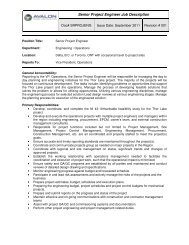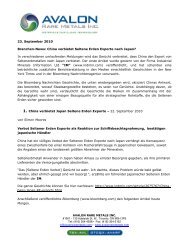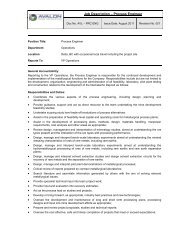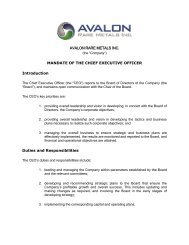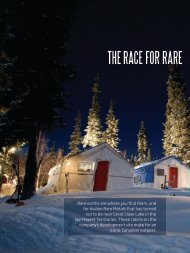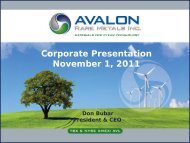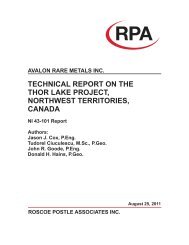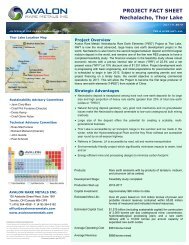technical report on the nechalacho deposit, thor lake project ...
technical report on the nechalacho deposit, thor lake project ...
technical report on the nechalacho deposit, thor lake project ...
You also want an ePaper? Increase the reach of your titles
YUMPU automatically turns print PDFs into web optimized ePapers that Google loves.
• To allow <strong>the</strong> observati<strong>on</strong>al approach to be utilized in <strong>the</strong> <strong>on</strong>going design, c<strong>on</strong>structi<strong>on</strong>,<br />
and operati<strong>on</strong> of <strong>the</strong> facility. The observati<strong>on</strong>al approach is a powerful technique that<br />
can deliver substantial cost savings and high level of safety. It also enhances<br />
knowledge and understanding of <strong>the</strong> site-specific c<strong>on</strong>diti<strong>on</strong>s. For this method to be<br />
applicable, <strong>the</strong> character of <strong>the</strong> <strong>project</strong> must be such that it can be altered during<br />
c<strong>on</strong>structi<strong>on</strong> (Peck, 1969).<br />
The c<strong>on</strong>structi<strong>on</strong> will be scheduled to ensure that <strong>the</strong>re is always sufficient storage capacity<br />
available in <strong>the</strong> facility to avoid overtopping. The embankment raising schedule provides<br />
sufficient freeboard to safely accommodate <strong>the</strong> supernatant p<strong>on</strong>d and Envir<strong>on</strong>mental Design<br />
Storm event, combined with wave run-up. A spillway is included to pass <strong>the</strong> Inflow Design<br />
Flood event.<br />
Opti<strong>on</strong>s Assessment<br />
A review of potential storage locati<strong>on</strong> opti<strong>on</strong>s was completed as part of 2009 studies. The<br />
review c<strong>on</strong>sidered slurry tailings disposal in seven different topographic basins within <strong>the</strong> Thor<br />
Lake <strong>project</strong> area as well as submarine tailings disposal in Thor, L<strong>on</strong>g and Elbow Lakes. The<br />
Ring and Buck Lake basin was selected as <strong>the</strong> preferred opti<strong>on</strong> based <strong>on</strong> an assessment of<br />
<str<strong>on</strong>g>technical</str<strong>on</strong>g>, envir<strong>on</strong>mental, ec<strong>on</strong>omic and socio-ec<strong>on</strong>omic factors.<br />
Design Basis<br />
The pre-feasibility level design of <strong>the</strong> Thor Lake TMF has been based <strong>on</strong> an approximate mine<br />
life of 15 years with a total ore reserve of approximately nine milli<strong>on</strong> t<strong>on</strong>nes. The average<br />
mining rate for <strong>the</strong> Nechalacho Deposit will begin at approximately 1,000 dry tpd and increase to<br />
2,000 dry tpd in year four of operati<strong>on</strong>s.<br />
Tailings and Water Management<br />
The tailings and water management strategy for <strong>the</strong> Thor Lake pre-feasibility design c<strong>on</strong>sists of<br />
a closed loop system to minimize impact to <strong>the</strong> natural hydrologic flows within <strong>the</strong> Thor Lake<br />
watershed area. All tailings solids and fluids as well as impacted water from <strong>the</strong> Process Plant<br />
will <str<strong>on</strong>g>report</str<strong>on</strong>g> to <strong>the</strong> Tailings Basin. The TMF design currently proposed includes a Polishing P<strong>on</strong>d,<br />
and excess water from <strong>the</strong> Tailings Basin will be treated (if necessary) and discharged from <strong>the</strong><br />
Polishing P<strong>on</strong>d to Drizzle Lake. Ultimately, all water from <strong>the</strong> TMF will return to Thor Lake via<br />
Drizzle and Murky Lakes. Fresh water for operati<strong>on</strong>s will be drawn from Thor Lake and reclaim<br />
water will be drawn from <strong>the</strong> Tailings Basin. The pre-feasibility water balance has assumed that<br />
<strong>the</strong> process water feed to <strong>the</strong> Process Plant will c<strong>on</strong>sist of 50% fresh water and 50% recycled<br />
water from <strong>the</strong> Tailings Basin<br />
Technical Report 43-101 – March 13, 2011 Page 18-43<br />
Prepared by Aval<strong>on</strong> Rare Metals Inc.






